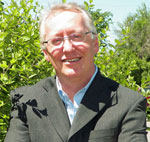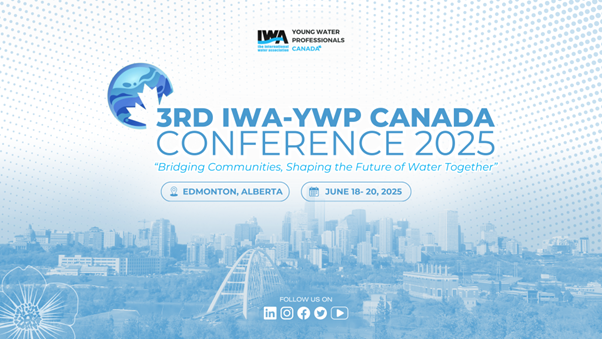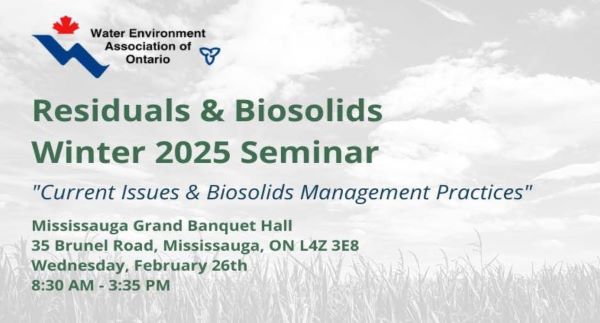 |
||||||||||||||||||||
| Subscribe | Past Issues | www.cwwa.ca | Water Source Magazine | ||||||||||||||||||||
|
CWWA News
A genuine pillar of the CWWA has retired. Adrian Toth, CWWA’s Director of Government Relations, is saying farewell after 24 years with the national association. As his title expresses, Adrian was responsible for creating, maintaining and strengthening CWWA’s relationships with ALL the federal departments, sections, agencies and commissions that deal with our municipal water sector. This seemed to be an easy task for Adrian because he is always such a sincere and likable person. Many of these professional “relationships” became genuine “friendships” over the many years he has been the face of the CWWA to the federal government. Now that 2025 is here, it’s time to start planning your Conference participation, and we want to make sure that the National Water and Wastewater Conference is on your list. Whether you attend as a speaker, delegate or exhibitor/sponsor, make sure you plan to be there! Would you like to present at THE national conference for Canada’s municipal water utility sector? Share your experience, research or case studies with national leaders on water and wastewater. We're seeking presentations on all aspects of water and wastewater management from drinking water, to wastewater to general utility management challenges. Our complete call for presentations is available online. When you're ready, you can submit your proposal through our online portal. Submit your short presentation proposal by March 28, 2025.
Federal Initiatives
Justin Trudeau has stepped down as the leader of the liberal party and prorogued government until March while the party finds a new leader. It is likely that when parliament resumes there will be a non-confidence vote triggering a federal election. This pauses most federal initiatives, and those underway face uncertainty especially considering increased inflation, a weak dollar and uncertain trade relationships with the United States. Health Canada has published the final Guidelines for Canadian Drinking Water Quality on Iron.. This change establishes "[a]n aesthetic objective (AO) of ≤ 0.1 mg/L (100 µg/L) [...] for total iron in drinking water." The Government of Canada recently published its first publicly available annual global mean temperature forecast, predicting that 2025 will be warmer than every year on record prior to 2023. The forecast anticipates a global mean temperature in the range of 1.35 °C to 1.55 °C above the pre-industrial value, meaning global temperatures in 2025 will remain at least 1.0 °C above pre-industrial levels for the 12th consecutive year. The forecast reaffirms that the significant increase in global temperatures over the past two years is not a temporary fluctuation, but a clear signal of the long-term global warming that is driven by greenhouse gas emissions. Looking ahead, Canada’s climate model predicts the next five years will be the warmest five-year period on record. The Canadian Minister of Health has announced their intention to establish a maximum acceptable concentration (MAC) for trihalomethanes (THMs) in drinking water as “0.100 mg/L (100 µg/L) based on a locational running annual average of a minimum of quarterly samples taken at the points in the distribution system with the highest potential for THM levels.” THMs would include four species: “chloroform, [Bromodichloromethane (BDCM], [Dibromochloromethane (DBCM)], and bromoform.” Comments can be submitted by 4 April 2025. CWWA's Drinking Water Quality Committee is reviewing the Guideline and will submit comments if there are any concerns witht the proposed MAC or supporting documentation. Member News
WEF is on a mission to better understand the challenges, drivers, and resource needs across the MS4 sector. This one-of-a-kind national survey seeks to understand Municipal Separate Storm Sewer System (MS4) sector challenges, drivers, and needs. Are you a young water professional ready to shape the future of sustainable water solutions? Join us in Edmonton, Alberta, from June 18–20, 2025. This conference will bring together diverse communities and sectors to explore innovative strategies, share best practices, and foster collaboration to address today’s critical water challenges. Together, we will pave the way for a sustainable future in water resources and innovation. April 29 – May 1, 2025 For over 30 years, CANECT has met the needs of Canada’s environmental managers, practitioners and supervisors. Attend CANECT25 to keep up-to-date with new environmental regulations and requirements, connect with expert speakers, prove your organization’s due diligence, earn Continuing Professional Development hours, and expand your awareness and network. Register by February 14 to save up to $295!
Abstract submissions are open for the 3rd Annual Water Efficiency & Conservation Symposium, happening August 6–8, 2025, in Chicago! Submit your proposal by March 7, 2025, at 5:00 pm Central to help shape a dynamic and diverse program. We’re looking to curate actionable research, practical resources, and hands-on learning tailored to water efficiency and conservation professionals, and we look forward to seeing your ideas! Snippings & Clippings
CNN Chemicals found in sewage sludge that some farmers use to fertilize fields and pastures can pose a threat to human and animal health, the US Environmental Protection Agency said Tuesday. Exposure to food from farms that use the sewage sludge can raise a person’s risk of developing cancer or other health conditions, it said. Under certain conditions, the human health risks from sludge used on farms are “several orders of magnitude” above what the EPA considers acceptable, the agency said. Manufacturing Net PFAS, or “forever chemicals” as they’re often called, have persisted their way into water, air, fish, soil, people and animals all over the country. They’ve been linked to several serious health problems including cancer. It’s a widespread problem that’s led many states to pursue legislation that would block their continued use. Stormwater Report Over half of the U.S. by area— nearly 485 million ha (1.2 billion ac) — consists of farmland, U.S. Department of Agriculture (USDA). Although this land is vital to the U.S food supply and economy, it also represents a significant source of water pollution. The Hill California Gov. Gavin Newsom (D) called for an independent investigation of the Los Angeles Department Water and Power on Friday amid reported water supply issues during this week’s wildfires. In a letter addressed to the CEO and chief engineer of the department and the director of LA County Public Works, Newsom called the reports “deeply troubling.” The Conversation Africa’s small-scale farmers make up nearly 80% of all farms in the agriculture sector. In South Africa, there are about 2 million small-scale farmers, predominantly Black and based in the eastern summer rainfall region of the country. Waste Today The U.S. Environmental Protection Agency (EPA) has added nine per- and polyfluoroalkyl substances to the list of chemicals covered by its Toxics Release Inventory. These nine PFAS were added to the inventory list pursuant to the 2020 National Defense Authorization Act, which provides the framework for the automatic addition of PFAS to the inventory each year in response to specified EPA activities involving such PFAS. Water Online As the water industry adapts to the current technological revolution, 2025 promises to be a pivotal year for integrating GIS advancements. With rapid developments in high-accuracy global navigation satellite systems (GNSS), indoor mapping, cloud computing, and remote sensing, GIS is poised to transform how water users manage infrastructure and resources. This evolution is about technology and properly equipping the industry with the tools to effectively navigate challenges like climate variability, regulatory compliance, and the impending workforce shift. CNN A group of potentially toxic “forever chemicals,” mostly coming from prescribed drugs, may be contaminating drinking water for millions of Americans, as wastewater treatment plants fail to remove them — and climate change may be making the situation even worse, according to a new report. Bloomberg Climate change and aging infrastructure already threaten to disrupt drinking water supplies. A shrinking workforce risks making the problem worse. Water Canada To help further reduce water waste in the City of Cranbrook, BC, and to improve leak detection across the entire water system, changes are coming to the enforcement of the Waterworks bylaw. At their regular meeting on January 13th, Council supported changes to the execution of the Waterworks bylaw, which already has provisions for meters, but this requirement had not been enforced. This exercise stems from a resolution of Council from February 2024 directing Administration to begin water meter readiness activities and required water meter readiness provisions to be installed as part of new developments and new or upgraded water services. Water Canada Veolia Canada has been awarded a five-year contract extension to continue operating and maintaining the City of Moncton’s drinking water treatment plant. The extension builds upon Veolia’s long-standing partnership with the city, which began in 1999. Water Canada In the spring of 2025, the CSA Group is planning to publish the W217 Ontario Wastewater Management System (WWMS) standard. The WWMS standard is a quality and environmental management standard, which brings together elements of the ISO 9001 standard for quality management, the ISO 14001 for environmental management, and the Ontario Drinking Water Quality Management Standard (DWQMS). Comparatively, the DWQMS (a statutorily required standard since 2009-10) draws on the ISO 9001, as well as the Hazard Analysis and Critical Control Points (HACCP) for the food industry, and also considered elements of ISO 14001 in its revised 2017 version. |
||||||||||||||||||||












